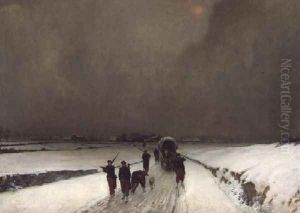Augustin Pierre Chenu Paintings
Augustin Pierre Chenu was a French painter born in 1833, amidst a period rich with cultural and artistic evolution in France. He was part of the mid-19th century European art scene, a time when realism was beginning to take hold, challenging the traditional romantic and neoclassical styles that had dominated the earlier part of the century. Chenu's work, although not as widely recognized as some of his contemporaries, provides a fascinating insight into the artistic movements and societal changes of his time.
Chenu's artistic journey was marked by his keen observation of everyday life and a profound interest in depicting the natural world with as much authenticity as possible. This inclination towards realism is evident in his detailed and vibrant portrayals of landscapes and rural scenes. He had a particular talent for capturing the subtle changes in light and shadow, a skill that imbued his landscapes with a sense of immediacy and vitality. His works often reflect the rural life of France, with a focus on the harmonious and sometimes challenging relationship between humans and nature.
Despite the quality and depth of his work, Chenu did not gain the same level of fame as some of his contemporaries, such as Gustave Courbet or Jean-François Millet, who were prominent figures in the Realism movement. However, his contributions to the French art scene were significant, particularly in his influence on the landscape genre. Chenu's dedication to capturing the essence of the French countryside helped to pave the way for future artists who sought to express the realities of their environment without idealization.
Augustin Pierre Chenu's career spanned a period of significant political, social, and technological changes in France, including the tumultuous events of the 1848 Revolution and the profound transformations brought about by the Second Industrial Revolution. These events influenced the themes and techniques of many artists of the time, as they sought to reflect the complexities and challenges of modern life. Chenu's work, with its focus on the natural and the real, offers a window into the world of 19th-century France, capturing the beauty of its landscapes and the spirit of its people.
Chenu passed away in 1898, leaving behind a legacy that, while perhaps not as celebrated as that of some of his peers, remains an important part of the tapestry of French art. His paintings continue to be appreciated for their contribution to the realism movement and for their embodiment of the spirit of an era. Through his detailed and thoughtful depictions of the French countryside, Augustin Pierre Chenu remains a figure of interest to art historians and lovers of French art, offering insights into the world that he observed with such care and skill.
